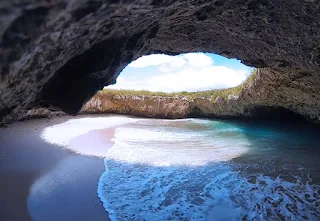The Marieta Islands are a group of small uninhabited islands a few miles off the coast of the state of Nayarit, Mexico, in federal waters 7.9 kilometres (4.9 mi) southwest of the peninsula known as Punta de Mita, in the municipality of Bahía de Banderas.
They are very popular tourist destinations because of the abundant marine life populations due to the islands being protected from fishing and hunting by the Mexican government. The depth around the islands is between 70 and 110 feet.
They are very popular tourist destinations because of the abundant marine life populations due to the islands being protected from fishing and hunting by the Mexican government. The depth around the islands is between 70 and 110 feet.
The Marietas Islands were originally formed many thousands of years ago by volcanic activity, and are completely uninhabited. The islands are about an hour long boat ride west-northwest from the coast of Puerto Vallarta and are visited daily by hundreds of tourists, yet no one can legally set foot on the islands. In the early 1900s the Mexican government began conducting military testing on the islands because no one lived there. Many bombings and large explosions took place on the islands causing caves and rock formations to be created. After a massive international outcry, started by scientist Jacques Cousteau in the late 1960s, the government eventually decided to label the islands a national park and therefore protected against any fishing, hunting or human activity.
Situated in a sort of open sun-drenched crater, this beach is affectionately nicknamed the "hidden beach" or "beach of love" (Playa del Amor), it is accessible only when the tide is low.
Situated in a sort of open sun-drenched crater, this beach is affectionately nicknamed the "hidden beach" or "beach of love" (Playa del Amor), it is accessible only when the tide is low.
The Islands are home to 44 different species of plants and wildlife. This has led to the inclusion of National Park in RAMSAR sites its designation as a UNESCO MAB Biosphere Reserve. Many species of seabirds use the location as feeding and breeding grounds, these include blue-footed boobies as well as the red-billed tropicbirds. It also has many different varieties of coral, which, in turn, is home to a large variety of reef fish species. The island ecosystem is also home to dolphins, Manta Rays and a number of tropical fish. Eels and many species of sea turtles are also found in the reefs and the many caves that dot the site. During the winter months humpback whales arrive at the islands and can be observed all through winter.
Protection by the government has created an environment conducive to the development of the marine ecosystem, and is a popular location for snorkeling and scuba diving. Not even during whale watching tours, people often report seeing sea turtles, manta rays, octopus, wild dolphins, humpback whales and thousands of species of tropical fish around the islands. The islands are also home to a few thousand birds, with species such as the blue-footed booby. Currently, the Mexican government allows only a few companies to go to the islands and allows the landing of passengers onto one secluded beach with the necessary permit from Semarnat.
From Punta de Mita, small boats do tours through the islands to see the wildlife of this region. From December to March gray and humpback whales can be observed that come from Alaska to give birth off the coast of Nayarit.
It has been estimated in studies carried out at the University of Guadalajara that the so-called "hidden beach" or the "love beach" can accommodate up to 116 visitors a day without degrading. The carrying capacity of the entire park is 625 visitors a day. (These studies used the antiquated system of Tourism carrying capacity to estimate visitors). However the actual number of visitors is typically three of four times this limit with more than 2500 visitors landing on it each day during 2016. During the Easter holidays more than 250 boats landed on the island per day, some of them carrying as many as 400 tourists. This has been due to recent interest in the Island. The number of tourists in 2012 was only 27,500, but this skyrocketed to 127,372 in 2015.
For More Details - Islas Marietas National Park




















No comments:
Post a Comment
Stay updated with our blog for more quality content! Your feedback is appreciated. Contact us at harshrex@outlook.com with any suggestions.